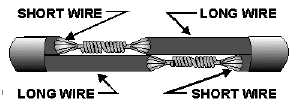2-6
Figure 2-5.—Western Union splice.
1. Prepare the wires for splicing. Enough insulation is removed to make the splice. The conductor
is cleaned.
2. Bring the wires to a crossed position and make a long twist or bend in each wire.
3. Wrap one end of the wire and then the other end four or five times around the straight portion of
each wire.
4. Press the ends of the wires down as close as possible to the straight portion of the wire. This
prevents the sharp ends from puncturing the tape covering that is wrapped over the splice. The
various types of tape and their uses are discussed later in this chapter.
Staggering Splices
Joining small multiconductor cables often presents a problem. Each conductor must be spliced and
taped. If the splices are directly opposite each other, the overall size of the joint becomes large and bulky.
A smoother and less bulky joint can be made by staggering the splices.
Figure 2-6 shows how a two-conductor cable is joined to a similar size cable by using a Western
Union splice and by staggering the splices. Care should be taken to ensure that a short wire from one side
of the cable is spliced to a long wire, from the other side of the cable. The sharp ends are then clamped
firmly down on the conductor. The figure shows a Western Union splice, but other types of splices work
just as well.
Figure 2-6.—Staggering splices.



